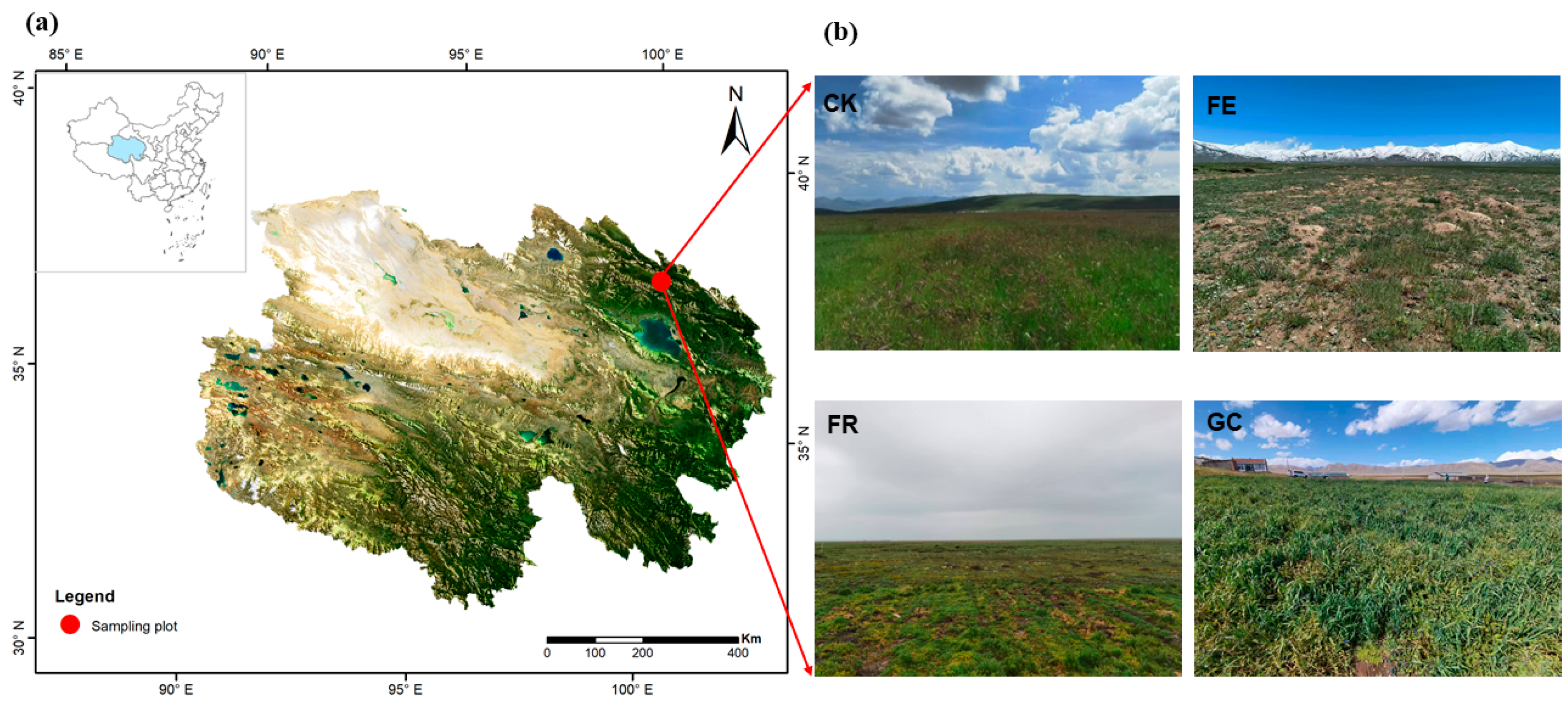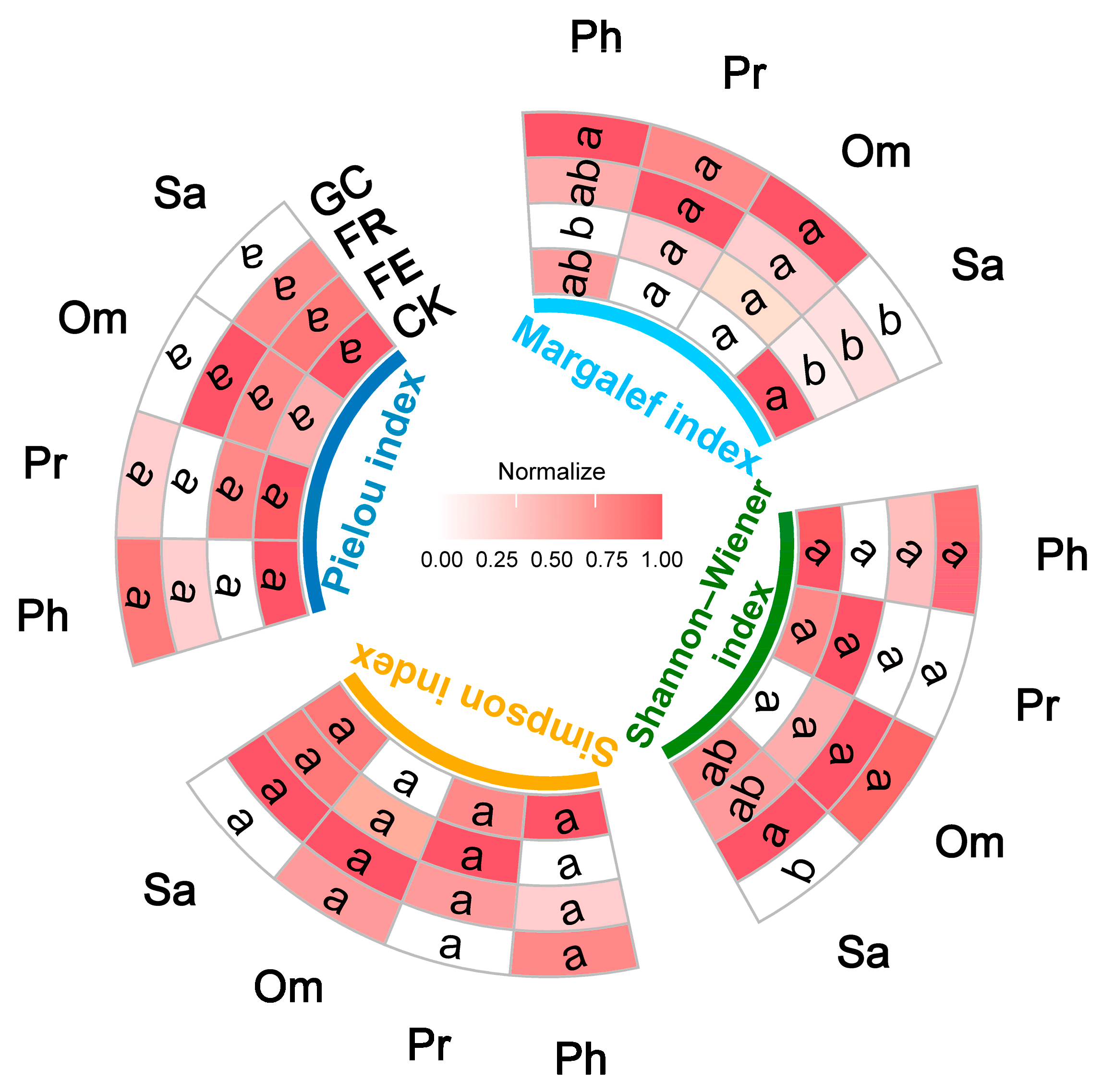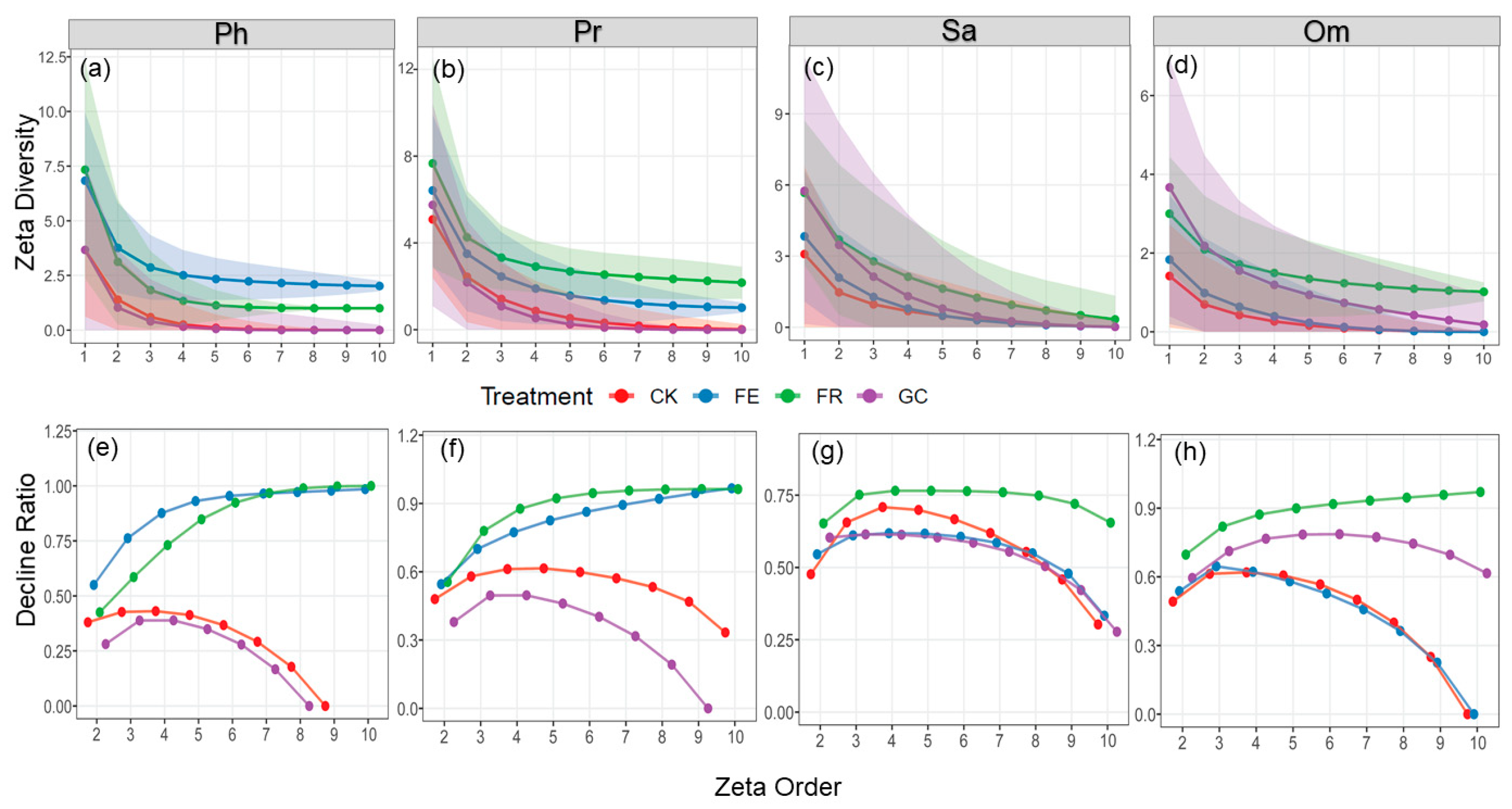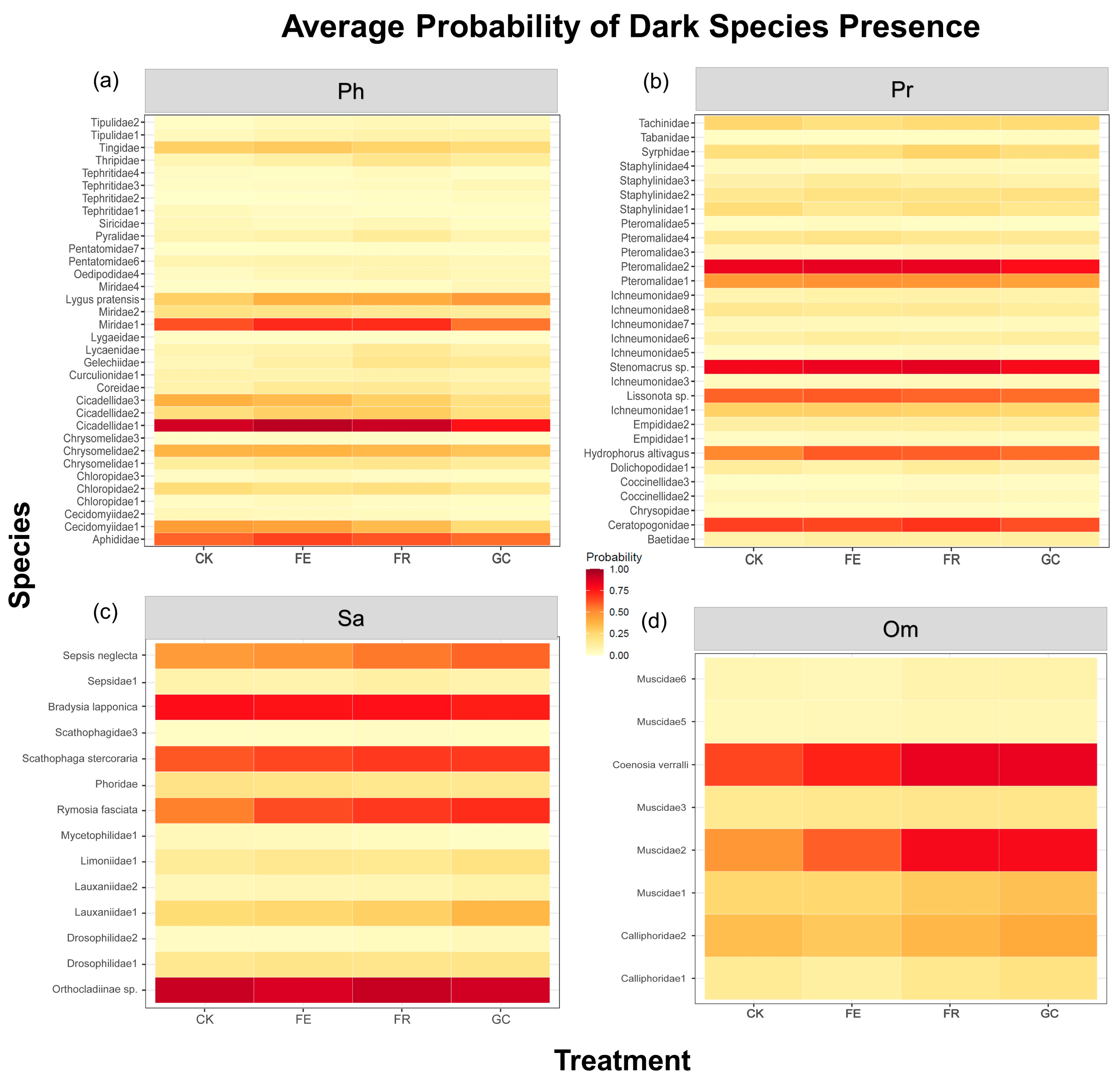Alpine Grassland Ecological Restoration Approaches Shape Insect Trophic Guild Diversity: A Multi-Dimensional Assessment from Alpha to Dark Diversity
Simple Summary
Abstract
1. Introduction
2. Materials and Methods
2.1. Study Site and Experimental Design
2.2. Insect Sampling
2.3. Data Analysis and Statistics
2.3.1. Alpha Diversity
2.3.2. Zeta Diversity
2.3.3. Dark Diversity
3. Results
3.1. Insect Community Composition
3.2. Effects of Restoration Treatments on Insect Alpha Diversity
3.3. Effects of Restoration Treatments on Insect Zeta Diversity
3.4. Effects of Restoration Treatments on Insect Dark Diversity
4. Discussion
4.1. Differential Effects of Restoration Measures on Insect Functional Group Diversity
4.2. Divergent Roles of Rare and Widespread Species in Community Assembly
4.3. Dark Diversity as a Novel Metric for Restoration Potential Assessment
4.4. Management Implications, Limitations, and Future Prospects
5. Conclusions
Supplementary Materials
Author Contributions
Funding
Data Availability Statement
Acknowledgments
Conflicts of Interest
References
- Sun, J.; Wang, Y.; Piao, S.L.; Liu, M.; Han, G.D.; Li, J.R.; Liang, E.Y.; Lee, T.M.; Liu, G.H.; Wilkes, A.; et al. Toward a sustainable grassland ecosystem worldwide Comment. Innovation 2022, 3, 10026. [Google Scholar] [CrossRef]
- Bai, Y.F.; Cotrufo, M.F. Grassland soil carbon sequestration: Current understanding, challenges, and solutions. Science 2022, 377, 603–608. [Google Scholar] [CrossRef]
- Wang, R.; Gamon, J.A.; Hogan, K.F.E.; Kellar, P.R.; Wedin, D.A. Prairie management practices influence biodiversity, productivity and surface-atmosphere feedbacks. New Phytol. 2025, 247, 562–576. [Google Scholar] [CrossRef]
- Chai, Y.; Xu, L.; Xu, Y.; Yang, K.; Zhu, R.; Zhang, R.; Li, X.X. Impact of Plateau Grassland Degradation on Ecological Suitability: Revealing Degradation Mechanisms and Dividing Potential Suitable Areas with Multi Criteria Models. Remote Sens. 2025, 17, 2539. [Google Scholar] [CrossRef]
- Liu, Y.Y.; Zhang, Z.Y.; Tong, L.J.; Khalifa, M.; Wang, Q.; Gang, C.C.; Wang, Z.Q.; Li, J.L.; Sun, Z.G. Assessing the effects of climate variation and human activities on grassland degradation and restoration across the globe. Ecol. Indic. 2019, 106, 105504. [Google Scholar] [CrossRef]
- Török, P.; Brudvig, L.A.; Kollmann, J.; Price, J.N.; Tóthmérész, B. The present and future of grassland restoration. Restor. Ecol. 2021, 29, e13378. [Google Scholar] [CrossRef]
- Duan, Y.L.; Zhao, J.H.; Zhang, J.B.; Wang, L.L.; Chen, Y.; Wang, X.Y.; Wu, F.S.; Li, Y.Q. Contrasting patterns and drivers of soil microbial communities in high-elevation montane grasslands and deserts of the Qinghai-Tibetan plateau in China. Catena 2025, 258, 109321. [Google Scholar] [CrossRef]
- Liu, P.P.; Zeng, H.J.; Qi, L.Y.; Degen, A.A.; Boone, R.B.; Luo, B.Y.; Huang, M.; Peng, Z.; Qi, T.Y.; Wang, W.Y.; et al. Vegetation redistribution is predicted to intensify soil organic carbon loss under future climate changes on the Tibetan Plateau. Sci. Total Environ. 2024, 932, 173034. [Google Scholar] [CrossRef]
- Dong, S.K.; Zhang, Y.; Shen, H.; Li, S.; Xu, Y.D. Grasslands on the Third Pole of the World: Structure, Function, Process, and Resilience of Social-Ecological Systems; Springer International Publishing: Cham, Switzerland, 2023; pp. 269–310. [Google Scholar]
- Chen, G.; Jia, Z.Q.; Bo, D.B.; Xianzi, H.L.; Xue, L.Q. Reviews and Prospects of Ecological Restoration Measures for Degraded Grasslands of China. Ecol. Environ. Sci. 2022, 31, 1465–1475. [Google Scholar] [CrossRef]
- He, J.S.; Liu, Z.P.; Yao, T.; Sun, S.C.; Lu, Z.; Hu, X.W.; Cao, G.M.; Wu, X.W.; Li, L.; Bu, H.Y.; et al. Analysis of the main constraints and restoration techniques of degraded grassland on the Tibetan Plateau. Sci. Technol. Rev. 2020, 38, 66–80. [Google Scholar] [CrossRef]
- Landmann, T.; Schmitt, M.; Ekim, B.; Villinger, J.; Ashiono, F.; Habel, J.C.; Tonnang, H.E.Z. Insect diversity is a good indicator of biodiversity status in Africa. Commun. Earth Environ. 2023, 4, 234. [Google Scholar] [CrossRef]
- Rusch, A.; D’Ottavio, M.; Hénon, N.; Joubard, B.; Thiéry, D.; Muneret, L. Functional identity of dominant species in a predator community prevails over functional diversity in shaping the top-down control of herbivores. Funct. Ecol. 2023, 37, 2666–2676. [Google Scholar] [CrossRef]
- Joly, F.X.; Coq, S.; Coulis, M.; David, J.F.; Hättenschwiler, S.; Mueller, C.W.; Prater, I.; Subke, J.A. Detritivore conversion of litter into faeces accelerates organic matter turnover. Commun. Biol. 2020, 3, 660. [Google Scholar] [CrossRef]
- Yang, H.; Duan, Y.Y.; Guo, Z.G.; Pang, X.P. Foraging tunnel disturbances created by small subterranean herbivores enhance soil organic carbon stability but reduce carbon sequestration in different alpine grassland types. Sci. Total Environ. 2024, 955, 176785. [Google Scholar] [CrossRef]
- Tsang, T.P.N.; De Santis, A.A.A.; Armas-Quiñonez, G.; Ascher, J.S.; Ávila-Gómez, E.S.; Báldi, A.; Ballare, K.M.; Balzan, M.V.; Banaszak-Cibicka, W.; Bänsch, S.; et al. Land Use Change Consistently Reduces α- But Not β- and γ-Diversity of Bees. Glob. Change Biol. 2025, 31, e70006. [Google Scholar] [CrossRef]
- Riva, F.; Mammola, S. Rarity facets of biodiversity: Integrating Zeta diversity and Dark diversity to understand the nature of commonness and rarity. Ecol. Evol. 2021, 11, 13912–13919. [Google Scholar] [CrossRef]
- Hui, C.; McGeoch, M.A. Zeta Diversity as a Concept and Metric That Unifies Incidence-Based Biodiversity Patterns. Am. Nat. 2014, 184, 684–694. [Google Scholar] [CrossRef]
- Pärtel, M.; Szava-Kovats, R.; Zobel, M. Dark diversity: Shedding light on absent species. Trends Ecol. Evol. 2011, 26, 124–128. [Google Scholar] [CrossRef] [PubMed]
- Moeslund, J.E.; Brunbjerg, A.K.; Clausen, K.K.; Dalby, L.; Flojgaard, C.; Juel, A.; Lenoir, J. Using dark diversity and plant characteristics to guide conservation and restoration. J. Appl. Ecol. 2017, 54, 1730–1741. [Google Scholar] [CrossRef]
- Zhao, W.; Yin, Y.L.; Li, S.X.; Liu, Y.; Liu, J.K.; Dong, Y.; Su, S.F.; Ji, L.H. The characteristics of bacterial communities in different vegetation types in the Qilian Mountains. Acta Prataculturae Sin. 2021, 30, 161–171. [Google Scholar] [CrossRef]
- Sui, Q.Q.; Yin, Y.L.; Zhao, W.; Dong, Y.L.; Song, J.Q.; Huo, J.Y.; Zheng, W.X.; Li, S.X. Effects of Different Grazing Intensities on Soil Nitrogen Use in Alpine Meadow in Spring. Acta Agrestia Sin. 2025, 33, 189–198. [Google Scholar] [CrossRef]
- Tang, K.Y.; Hilal, M.G.; Yue, H.R.; Ding, X.L.; Xing, Y.F.; Zhao, J.M.; Liu, Y.; Liu, H.; He, Z.L.; Lin, K.J.; et al. Climatic seasonality shapes insect community composition on the Mongolian Plateau. Ecol. Indic. 2025, 175, 113595. [Google Scholar] [CrossRef]
- Hassan, N.; Wang, Z.W.; Zhu, Y. Effect of paralleled grazing and mowing on stoichiometric linkages and insect community composition in semi-arid grassland. J. Environ. Manag. 2025, 382, 125419. [Google Scholar] [CrossRef]
- Li, Y.H.; Liu, Q.; Zhang, X.M.; Mao, B.Y.; Yang, G.H.; Shi, F.M.; Bi, J.G.; Ma, Z.B.; Tang, G.W. Effects of Environmental Factors on the Diversity of Grasshopper Communities along Altitude Gradients in Xizang, China. Insects 2024, 15, 671. [Google Scholar] [CrossRef]
- Cai, W.Z.; Pang, X.F.; Hua, B.Z.; Liang, G.W.; Song, D.L. General Entomology; China Agricultural University Press: Beijing, China, 2011; pp. 284–372. [Google Scholar]
- Zhang, W.W.; Li, Y.S. Chinese Insects Illustrated; Chongqing University Press: Chongqing, China, 2011; pp. 379–404. [Google Scholar]
- Yang, M.F.; Mang, Z.H.; Li, Z.Z. Fauna Sinica Insecta; Science Press: Beijing, China, 2017; Volume 67, p. 637. [Google Scholar]
- Krafsur, E.S.; Moon, R.D.; Albajes, R.; Alomar, O.; Chiappini, E.; Huber, J.; Capinera, J.L.; Heppner, J.B.; Heppner, J.B.; Heppner, J.B.; et al. Food Habits of Insects. In Encyclopedia of Entomology; Capinera, J.L., Ed.; Springer: Dordrecht, The Netherlands, 2008; pp. 1504–1512. [Google Scholar]
- Wang, Y.D.; Cheng, J.W.; Wuji, S.G.L.; Li, H.X.; Wang, Y.N.; Guo, J.P.; Liu, X.M.; Li, F.Y. Effects of grazing and mowing on ground-dwelling predatory arthropods in a semi-arid grassland. Ecol. Indic. 2024, 167, 112733. [Google Scholar] [CrossRef]
- McGeoch, M.A.; Latombe, G.; Andrew, N.R.; Nakagawa, S.; Nipperess, D.A.; Roigé, M.; Marzinelli, E.M.; Campbell, A.H.; Vergés, A.; Thomas, T.; et al. Measuring continuous compositional change using decline and decay in zeta diversity. Ecology 2019, 100, e02832. [Google Scholar] [CrossRef] [PubMed]
- Parra-Sanchez, E.; Latombe, G.; Mills, S.C.; Socolar, J.B.; Edwards, F.A.; Martinez-Revelo, D.; Perez-Escobar, O.A.; Davies, R.W.; Bousfield, C.G.; Cerullo, G.R.; et al. Tropical Land-Use Change Disrupts Zeta-Diversity Across Taxa. Glob. Change Biol. 2025, 31, e70245. [Google Scholar] [CrossRef] [PubMed]
- Chen, J.; Zheng, F.C.; Li, D.P.; Zhou, R.X.; Jv, W.; Leng, X.; Xia, L.; An, S.Q. Zeta Diversity Reveals the Small Wetland Complex Promotes Biodiversity. Water 2024, 16, 476. [Google Scholar] [CrossRef]
- Gavriel, T.; Azzurro, E.; Benedetti-Cecchi, L.; Bertocci, I.; Cai, L.L.; Claudet, J.; Di Franco, A.; Frid, O.; Guidetti, P.; Kleitou, P.; et al. Using dark diversity to disentangle the effects of protection and habitat quality on species diversity. Biol. Conserv. 2025, 305, 111096. [Google Scholar] [CrossRef]
- Belinchón, R.; Hemrová, L.; Münzbergová, Z. Functional traits determine why species belong to the dark diversity in a dry grassland fragmented landscape. Oikos 2020, 129, 1468–1480. [Google Scholar] [CrossRef]
- Trindade, D.P.F.; Pärtel, M.; Carmona, C.P.; Randlane, T.; Nascimbene, J. Integrating dark diversity and functional traits to enhance nature conservation of epiphytic lichens: A case study from Northern Italy. Biodivers. Conserv. 2021, 30, 2565–2579. [Google Scholar] [CrossRef]
- Pärtel, M.; Szava-Kovats, R.; Zobel, M. Community Completeness: Linking Local and Dark Diversity within the Species Pool Concept. Folia Geobot. 2013, 48, 307–317. [Google Scholar] [CrossRef]
- Storey, J.D. A direct approach to false discovery rates. J. R. Statist. Soc. B 2002, 64, 479–498. [Google Scholar] [CrossRef]
- Efron, B.; Tibshirani, R. Statistical data analysis in the computer age. Science 1991, 253, 390–395. [Google Scholar] [CrossRef]
- de Mendiburu, F. Agricolae: Statistical Procedures for Agricultural Research Package. 2025. R Package Version 1.3-7. Available online: https://cran.r-project.org/web/packages/agricolae/agricolae.pdf (accessed on 15 October 2025).
- Wickham, H.; Chang, W.; Henry, L.; Pedersen, T.L.; Takahashi, K.; Wilke, C.O.; Yutani, H.; Dunnington, D.; van den Brand, T.; Posit, P. Ggplot2 Package: Create Elegant Data Visualisations Using the Grammar of Graphics. 2025. R Package Version 4.0.0. Available online: https://CRAN.R-project.org/package=ggplot2/ggplot2.pdf (accessed on 15 October 2025).
- Cao, Z.Y.; Zhang, H.X.; Xiong, C.Y.; Cui, Y.F.; Wang, Y.; Shi, C.; Ban, L.P.; Zhang, R.; Wei, S.H. Effects of different types of steppe fencings on insect diversity. J. Plant Prot. 2024, 51, 1189–1202. [Google Scholar] [CrossRef]
- Scott, D.A.; Baer, S.G. Diversity patterns from sequentially restored grasslands support the ‘environmental heterogeneity hypothesis’. Oikos 2019, 128, 1116–1122. [Google Scholar] [CrossRef]
- Wang, W.J.; Hou, F.J. Grazing modified the effects of insects on plants in grasslands: A meta-analysis. Eur. J. Agron. 2025, 171, 127787. [Google Scholar] [CrossRef]
- Hu, X.J.; Sun, Q.C.; Zhang, S.Z.; Li, W.S.; Wang, X.R.; Long, R.Z.; Jin, G.L.; Zhang, B. Effects of No-Till Seeding and Fertilization on Vegetation Restoration and Soil Physicochemical Properties in Alpine Degraded Grazing Grasslands. Agronomy 2025, 15, 578. [Google Scholar] [CrossRef]
- Zhu, H.; Wang, D.L.; Guo, Q.F.; Liu, J.; Wang, L. Interactive effects of large herbivores and plant diversity on insect abundance in a meadow steppe in China. Agric. Ecosyst. Environ. 2015, 212, 245–252. [Google Scholar] [CrossRef]
- Ríos-Díaz, C.L.; Moreno, C.E.; Ortega-Martínez, I.J.; Zuria, I.; Escobar, F.; Castellanos, I. Sheep herding in small grasslands promotes dung beetle diversity in a mountain forest landscape. J. Insect Conserv. 2020, 25, 13–26. [Google Scholar] [CrossRef]
- Sharma Acharya, R.; Leslie, T.; Burke, J.; Naithani, K.; Fitting, E.; Loftin, K.; Joshi, N.K. Sheep grazing influences the abundance, diversity, and community composition of wild bees and other insects in livestock pastures. Ecol. Indic. 2024, 162, 111839. [Google Scholar] [CrossRef]
- Silva, R.A.d.; Degrande, P.; Souza, E.P.d.; Carducci, C.E.; Leal, M.F.; Pereira, M.D.C. Entomofauna associated with Avena sativa in southern Mato Grosso do Sul, Brazil. Arq. Inst. Biol. 2019, 86, 1808. [Google Scholar] [CrossRef]
- Hou, D.J.; He, W.M.; Liu, C.C.; Qiao, X.G.; Guo, K. Litter accumulation alters the abiotic environment and drives community successional changes in two fenced grasslands in Inner Mongolia. Ecol. Evol. 2019, 9, 9214–9224. [Google Scholar] [CrossRef]
- Yu, L.F.; Sun, W.J.; Zhang, H.Y.; Cong, N.; Chen, Y.; Hu, J.J.; Jing, X. Grazing exclusion jeopardizes plant biodiversity effect but enhances dryness effect on multifunctionality in arid grasslands. Agric. Ecosyst. Environ. 2024, 363, 108883. [Google Scholar] [CrossRef]
- Guan, H.H.; Zhang, S.Y.; Huangpu, Y.F.; Yan, H.; Niklas, K.J.; Mipam, T.D.; Sun, S.C. Moderate Grazing Promotes Arthropod Species Diversity in an Alpine Meadow. Biology 2023, 12, 778. [Google Scholar] [CrossRef]
- Noriega, J.A.; Hortal, J.; deCastro-Arrazola, I.; Alves-Martins, F.; Ortega, J.C.G.; Bini, L.M.; Andrew, N.R.; Arellano, L.; Beynon, S.; Davis, A.L.V.; et al. Dung removal increases under higher dung beetle functional diversity regardless of grazing intensification. Nat. Commun. 2023, 14, 8070. [Google Scholar] [CrossRef] [PubMed]
- Stein, A.; Gerstner, K.; Kreft, H. Environmental heterogeneity as a universal driver of species richness across taxa, biomes and spatial scales. Ecol. Lett. 2014, 17, 866–880. [Google Scholar] [CrossRef]
- Benites, P.; García-Bautista, A.; Bautista-Briseño, N.; Zárate-Hernández, F.E.; del-Val, E.; Hernández-López, A.; Ramírez-García, E.; Zavala-de la Rosa, D.P.; Vogler, A.P.; Zaldívar-Riverón, A. Drivers of Insect Diversity and Community Turnover in Protected Tropical Deciduous Forests of Mexico. Environ. DNA 2025, 7, e70143. [Google Scholar] [CrossRef]
- Wallisdevries, M. Grazing and Biodiversity: From Selective Foraging to Wildlife Habitats; Options Méditerranéennes; CIHEAM: Zaragoza, Spain, 2016; pp. 195–196. [Google Scholar]
- Tiainen, J.; Hyvönen, T.; Hagner, M.; Huusela-Veistola, E.; Louhi, P.; Miettinen, A.; Nieminen, T.M.; Palojärvi, A.; Seimola, T.; Taimisto, P.; et al. Biodiversity in intensive and extensive grasslands in Finland: The impacts of spatial and temporal changes of agricultural land use. Agric. Food Sci. 2020, 29, 68–97. [Google Scholar] [CrossRef]
- Carmona, C.P.; Pärtel, M. Estimating probabilistic site-specific species pools and dark diversity from co-occurrence data. Glob. Ecol. Biogeogr. 2021, 30, 316–326. [Google Scholar] [CrossRef]
- Ma, L.X.; Wang, X.; Fang, Y.Y.; Vancov, T.; Jin, X.Y.; Gao, Q.Q.; Dong, W.X.; Du, Z.L. No-tillage farming for two decades increases plant- and microbial-biomolecules in the topsoil rather than soil profile in temperate agroecosystem. Soil Tillage Res. 2024, 241, 106108. [Google Scholar] [CrossRef]
- Lewis, R.J.; de Bello, F.; Bennett, J.A.; Fibich, P.; Finerty, G.E.; Götzenberger, L.; Hiiesalu, I.; Kasari, L.; Lepš, J.; Májeková, M.; et al. Applying the dark diversity concept to nature conservation. Conserv. Biol. 2016, 31, 40–47. [Google Scholar] [CrossRef]
- Wani, S.A.; Ahmad, R.; Dar, F.A.; Rasray, B.A.; Lone, S.A.; Shafee, F.; Rashid, I.; Khuroo, A.A. Estimating dark diversity and regional species pool in the high-altitude Himalayan habitats. Biodivers. Conserv. 2023, 32, 2981–2999. [Google Scholar] [CrossRef]
- Rowen, E.K.; Regan, K.H.; Barbercheck, M.E.; Tooker, J.F. Is tillage beneficial or detrimental for insect and slug management? A meta-analysis. Agr. Ecosyst. Environ. 2020, 294, 106849. [Google Scholar] [CrossRef]
- Bennett, G.M.; O’Grady, P.M. Host–plants shape insect diversity: Phylogeny, origin, and species diversity of native Hawaiian leafhoppers (Cicadellidae: Nesophrosyne). Mol. Phylogenet. Evol. 2012, 65, 705–717. [Google Scholar] [CrossRef] [PubMed]
- Du, C.C.; Chen, J.; Jiang, L.Y.; Qiao, G.X. High correlation of species diversity patterns between specialist herbivorous insects and their specific hosts. J. Biogeogr. 2020, 47, 1232–1245. [Google Scholar] [CrossRef]
- Opedal, O.H.; Ovaskainen, O.; Saastamoinen, M.; Laine, A.L.; Nouhuys, S. Host-plant availability drives the spatiotemporal dynamics of interacting metapopulations across a fragmented landscape. Ecology 2020, 101, e03186. [Google Scholar] [CrossRef]
- Rischen, T.; Frenzel, T.; Fischer, K. Biodiversity in agricultural landscapes: Different non-crop habitats increase diversity of ground-dwelling beetles (Coleoptera) but support different communities. Biodivers. Conserv. 2021, 30, 3965–3981. [Google Scholar] [CrossRef]
- Coulis, M. Abundance, biomass and community composition of soil saprophagous macrofauna in conventional and organic sugarcane fields. Appl. Soil Ecol. 2021, 164, 103923. [Google Scholar] [CrossRef]
- Wang, C.Q.; Bian, Z.X.; Zhang, Y.F.; Guan, D.Y. Direct and indirect effects of linear non-cultivated habitats on epigaeic macroarthropod assemblages. Ecol. Indic. 2024, 160, 111871. [Google Scholar] [CrossRef]
- Chollet, S.; Dano, M.; Thiébaut, G.; Jung, V. Dark diversity and habitat conservation status: Two sides of the same coin for conservation and restoration? Ecol. Indic. 2025, 170, 112990. [Google Scholar] [CrossRef]






Disclaimer/Publisher’s Note: The statements, opinions and data contained in all publications are solely those of the individual author(s) and contributor(s) and not of MDPI and/or the editor(s). MDPI and/or the editor(s) disclaim responsibility for any injury to people or property resulting from any ideas, methods, instructions or products referred to in the content. |
© 2025 by the authors. Licensee MDPI, Basel, Switzerland. This article is an open access article distributed under the terms and conditions of the Creative Commons Attribution (CC BY) license (https://creativecommons.org/licenses/by/4.0/).
Share and Cite
Tang, K.; Yue, H.; Qu, H.; Xing, Y.; Qin, B.; Wang, A.; Lin, K.; Shi, K.; Wang, N. Alpine Grassland Ecological Restoration Approaches Shape Insect Trophic Guild Diversity: A Multi-Dimensional Assessment from Alpha to Dark Diversity. Insects 2025, 16, 1140. https://doi.org/10.3390/insects16111140
Tang K, Yue H, Qu H, Xing Y, Qin B, Wang A, Lin K, Shi K, Wang N. Alpine Grassland Ecological Restoration Approaches Shape Insect Trophic Guild Diversity: A Multi-Dimensional Assessment from Alpha to Dark Diversity. Insects. 2025; 16(11):1140. https://doi.org/10.3390/insects16111140
Chicago/Turabian StyleTang, Kuanyan, Hongru Yue, Haijuan Qu, Yifang Xing, Bingshuang Qin, Aosheng Wang, Kejian Lin, Kun Shi, and Ning Wang. 2025. "Alpine Grassland Ecological Restoration Approaches Shape Insect Trophic Guild Diversity: A Multi-Dimensional Assessment from Alpha to Dark Diversity" Insects 16, no. 11: 1140. https://doi.org/10.3390/insects16111140
APA StyleTang, K., Yue, H., Qu, H., Xing, Y., Qin, B., Wang, A., Lin, K., Shi, K., & Wang, N. (2025). Alpine Grassland Ecological Restoration Approaches Shape Insect Trophic Guild Diversity: A Multi-Dimensional Assessment from Alpha to Dark Diversity. Insects, 16(11), 1140. https://doi.org/10.3390/insects16111140





